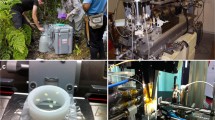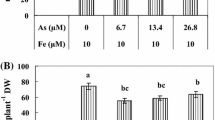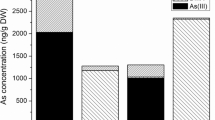Abstract
Synchrotron radiation X-ray fluorescence spectroscopy (SRXRF) was used to study the cellular distributions of arsenic and other elements in root, petiole, pinna of a newly discovered arsenic hyperaccumulator,Pteris nervosa. It was shown that there was a trend inP. nervosa to transport arsenic from cortex tissue to vascular tissue in root, and keep arsenic in vascular during transportation in petiole, and transport arsenic from vascular tissue to adaxial cortex tissues in midrib of pinnae. More arsenic was accumulated in mesophyll than in epidermis in pinnae. The distributions of some elements, such as K, Ca, Mn, Fe, Cu, Zn, in petiole, midrib and pinna were similar to that of arsenic, indicating that those cations might cooperate with arsenic in those transportation processes; whereas the distributions of Cl and Br in pinna were the reverse of that of arsenic, indicating that those anions might compete with arsenic in pinna ofP. nervosa.
Similar content being viewed by others
References
Chen, T. B., Wei, C. Y., Huang, Z. C. et al., Arsenic hyperaccumulatorPteris vittata L. and its arsenic accumulation, Chinese Science Bulletin, 2002, 47(7): 903–905.
Wei, C. Y., Chen, T. B., Huang, Z. C. et al., Cretan brake (Pteris cretica L.): an arsenic-accumulation plant, Acta Ecologica Sinica (in Chinese), 2002, 22(5): 777–778.
Zhao, F. J., Dunham, S. J., McGrath, S. P., Arsenic hyperaccumulation by different fern species, New Phytologist, 2002, 156: 27–31.
Meharg, A. A., Variation in arsenic accumulation-hyperaccumulation in ferns and their allies, New Phytologist, 2003, 157: 25–31.
Vesk, P. A., Nockolds, C. E., Allaway, W. G., Metal localization in water hyacinth root from an urban wetland, Plant, Cell and Environment, 1999, 22: 149–158.
Chen, T. B., Fan, Z. L., Lei, M. et al., Effect of phosphorus on arsenic accumulation in As-hyperaccumulator and its implication, Chinese Science Bulletin, 2002, 47(22): 1876–1879.
Walter, J. F., Walter, W. W., Arsenic transformations in the soil-rhizosphere-plant system: fundamentals and potential application to phytoremediation, Journal of Biotechnology, 2002, 99: 259–278.
Fransesconi, K., Visoottiviseth, P., Sridokchan, W. et al., Arsenic species in an arsenic hyperaccumulating fern,Pityrogramma calomelanos: a potential phytoremediator of arsenic-contaminated soils, The Science of the Total Environment, 2002, 284: 27–35.
Lombi, E., Zhao, F. J., Fuhrmann, M. et al., Arsenic distribution and speciation in the fronds of the hyperaccumulatorPteris vittata, New Phytologist, 2002, 156: 195–203.
Monni, S., Bücking, H., Kottke, I., Ultrastructural element localization by EDXS inEmpetrum nigrum, Micron., 2002, 33: 339–351.
Colleen, M. H., Matthew, J. L. F., Scott, F. et al., Spatial and temporal association of As and Fe species on aquatic plant roots, Environmental Science & Technology, 2002, 36: 1988–1994.
Wu, Y. R., Cao, Z. Y., Xiao, Y. A. et al., XRF experiments at BSRF., Nuclear Instruments and Methods in Physics Research A, 1995, 359: 291–294.
Ager, F. J., Ynsa, M. D., Domínguez-Solís, J. R. et al., Cadmium localization and quantification in the plantArabidopsis thaliana using micro-PIXE, Nuclear Instruments and Methods in Physics Research B, 2002, 189: 494–498.
Liu, N. Q., Liu, P. S., Wang, K. J. et al., A SXRF method for determining the relative concentration of trace elements in plasma protein affected by cisplatin, Biological Trace Element Research, 2000, 76: 279–284.
Küpper, H., Zhao, F. J., McGrath, S. P., Cellular compartmentation of zinc in leaves of the hyperaccumulatorThlaspi Caerulescens, American Society of Plant Physiologists, 1999, 119: 305–311.
Küpper, H., Lombi, E., Zhao, F. J. et al., Cellular compartmentation of cadmium and zinc in relation to other elements in the hyperaccumulatorArabidopsis Halleri, Planta, 2000, 212: 75–84
Otte, M. L., Dekkers, M. J., Rozema, J. et al., Uptake of arsenic byAster tripolium in relation to rhizosphere oxidation, Canadian Journal of Botany, 1991, 69(12): 2670–2677.
Meharg, A. A., MacNair, M. R., Suppression of the high affinity phosphate uptake system: a mechanism of arsenate tolerance inHolcus lanatus L, Journal of Experimental Botany, 1992, 43(249): 519–524.
Meharg, A. A., Naylor, J., Macnair, M. R., Phosphorus nutrition of arsenate-tolerant and nontolerant phenotypes of Velvetgrass, Journal of Environmental Quality, 1994, 23(2): 234–238.
Wang, J., Zhao, F. J., Meharg, A. A. et al., Mechanisms of arsenic hyperaccumulation inPteris vittata: Uptake kinetics, interactions with phosphate, and arsenic speciation, Plant Physiology, 2002, 130: 1552–1561.
Author information
Authors and Affiliations
Corresponding author
About this article
Cite this article
Chen, T., Huang, Z., Huang, Y. et al. Cellular distribution of arsenic and other elements in hyperaccumulatorPteris nervosa and their relations to arsenic accumulation. Chin. Sci. Bull. 48, 1586–1591 (2003). https://doi.org/10.1007/BF03183966
Received:
Accepted:
Issue Date:
DOI: https://doi.org/10.1007/BF03183966




